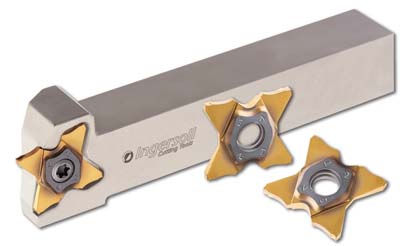Contact Details

Ingersoll Cutting Tools offers Gold-Flex, the new product line that features a 4-edged insert for multifunctional operations. Suitable for grooving, parting, lateral turning and chamfer machining, Gold-Flex provides excellent performance, repeatability and economy.
Gold-Flex inserts feature a high-positive chip former that enables machining in multiple applications while providing excellent chip control in plunging and lateral turning operations. The result is excellent surface finish as the chips are broken and moved away from the work piece.
The clamping system features a side torx screw and 3 contact points for stability and durability under demanding machining conditions. Insert indexing and changing is simple and accurate, and combined with the 4 cutting edge feature makes Gold-Flex an economical and efficient tooling system. This unique clamping design also protects the cutting edges that are not in use. Thus, if one or more of the edges are broken, the insert can simply be indexed to a new edge without adversely affecting the insert seating position.
Gold-Flex is available in widths from .020" to .125" (.5mm — 3.18mm). Lead angles and full radius inserts are also available as standard items. All inserts are available in grade TT9080, a versatile grade suitable for machining a wide variety of materials.
Related Glossary Terms
- grooving
grooving
Machining grooves and shallow channels. Example: grooving ball-bearing raceways. Typically performed by tools that are capable of light cuts at high feed rates. Imparts high-quality finish.
- parting
parting
When used in lathe or screw-machine operations, this process separates a completed part from chuck-held or collet-fed stock by means of a very narrow, flat-end cutting, or parting, tool.
- turning
turning
Workpiece is held in a chuck, mounted on a face plate or secured between centers and rotated while a cutting tool, normally a single-point tool, is fed into it along its periphery or across its end or face. Takes the form of straight turning (cutting along the periphery of the workpiece); taper turning (creating a taper); step turning (turning different-size diameters on the same work); chamfering (beveling an edge or shoulder); facing (cutting on an end); turning threads (usually external but can be internal); roughing (high-volume metal removal); and finishing (final light cuts). Performed on lathes, turning centers, chucking machines, automatic screw machines and similar machines.









 PRODUCTS
PRODUCTS

